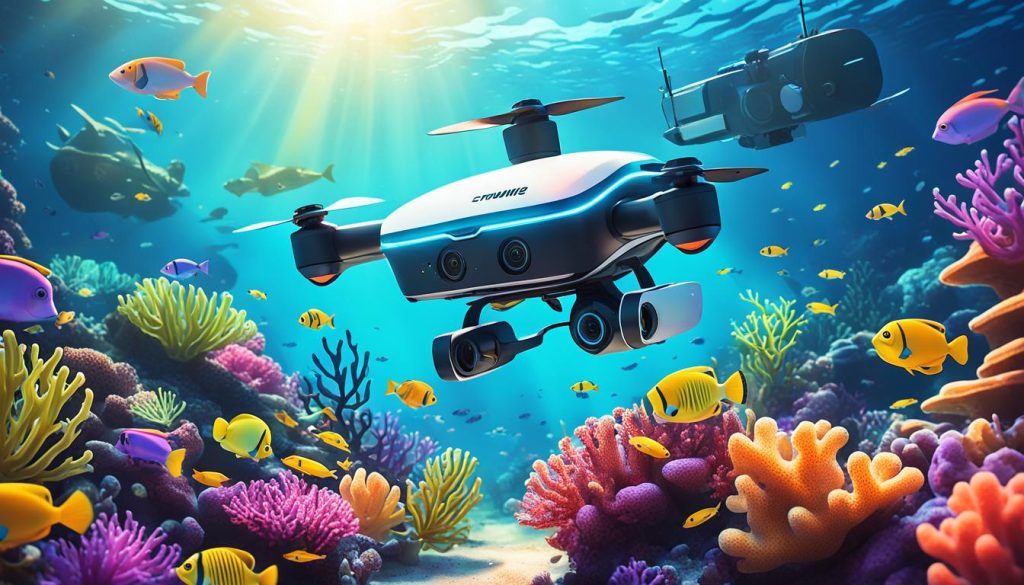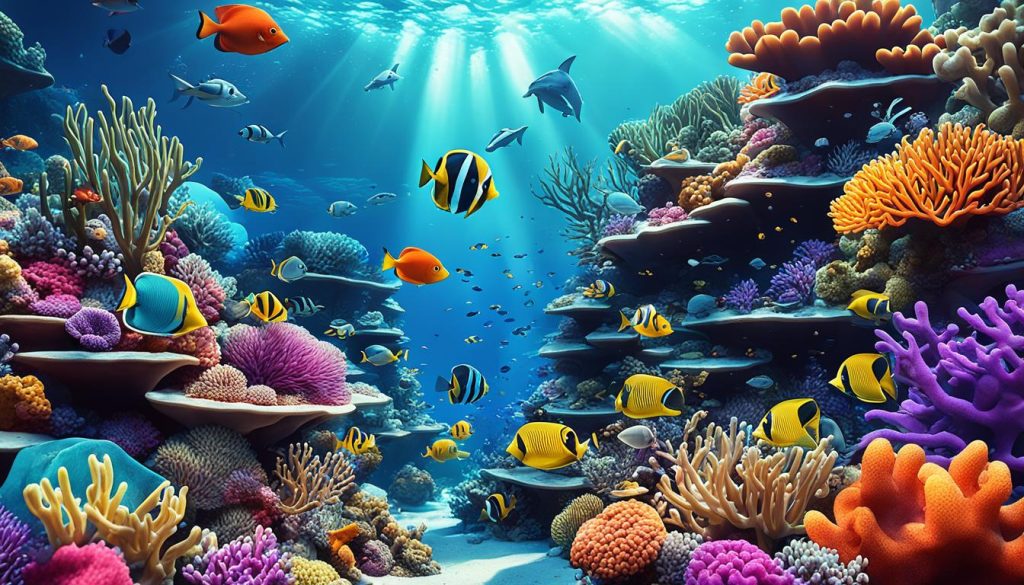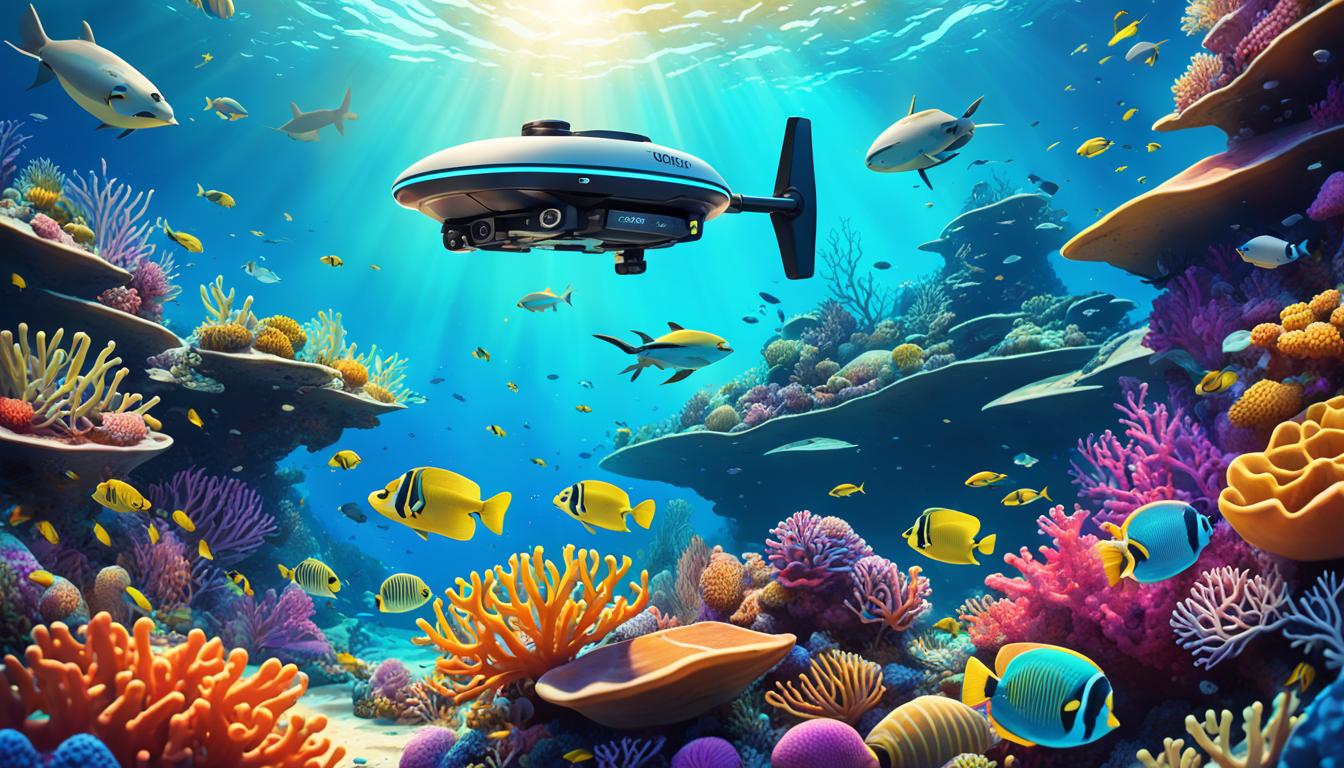To capture stunning underwater drone footage of coral reefs, you need special gear and skills. Underwater drone photography lets you see the ocean in a new way. It combines advanced technology with the beauty of the sea.
Underwater drones give you a fresh view of coral reefs. They come with sensors that measure coral color and shape. This tech is changing how we study coral reefs, like exploring the Great Barrier Reef.
When you start with underwater drone photography, you’ll see how it helps track coral changes. This info is crucial for scientists and those working to save coral reefs.
Understanding the Underwater Environment
Diving into underwater cinematography and reef ecology requires a deep understanding of the ocean’s unique world. This knowledge is key for capturing beautiful footage and documenting marine ecosystems accurately.
Coral Reef Ecosystems
Coral reefs are full of life and color. They are complex ecosystems with many marine species. This makes them perfect for underwater filming. You’ll see detailed coral structures, schools of colorful fish, and interesting invertebrates.
Light Penetration and Water Clarity
Light acts differently underwater, impacting your footage quality. As you go deeper, colors fade and it gets harder to see. The clarity of the water changes with the location and conditions. For the best reef ecology footage, try to stay within 20-30 feet of the surface where the light is strongest.
| Depth (feet) | Light Penetration | Color Visibility |
|---|---|---|
| 0-10 | Excellent | Full spectrum |
| 10-30 | Good | Reds begin to fade |
| 30-60 | Moderate | Blues dominate |
| 60+ | Poor | Limited color range |
Marine Life Behavior
Knowing how marine life acts is crucial for getting real footage. Fish and sea creatures react differently to divers or equipment. With patience and careful watching, you can predict their movements and interactions. This will improve your underwater filming skills.
By understanding these underwater aspects, you’ll be ready to document reef ecology and make stunning underwater films. These films will show the beauty and complexity of coral reef ecosystems.
Choosing the Right Underwater Drone
Finding the right underwater drone is key for capturing amazing footage of coral reefs. The right choice affects the quality of your videos and the success of your underwater projects.
Key Features to Consider
When choosing an underwater drone, keep these important features in mind:
- Waterproof capabilities
- Camera quality
- Depth rating
- Maneuverability
- Battery life
Choose drones with high-resolution cameras and strong lighting for clear, vibrant footage in dark underwater settings.
Popular Underwater Drone Models
Here are some top underwater drones for filming:
| Model | Key Features | Price Range |
|---|---|---|
| FIFISH V6 | 6 vector thrusters, 4K camera | $2,000 – $3,000 |
| PowerVision PowerRay | 4K UHD camera, 98ft tether | $1,000 – $1,500 |
| Chasing M2 | 4K/30fps video, 8x lights | $2,500 – $3,500 |
Budget Considerations
When planning your budget for underwater drone filming, consider:
- The drone itself
- Additional accessories (extra batteries, storage cases)
- Potential underwater housing for non-waterproof cameras
- Maintenance and repair costs
Investing in a quality underwater drone can greatly improve your videography and the quality of your footage.
Essential Equipment for Underwater Filming
For underwater drone photography and exploring coral reefs, you need special gear. A top-notch underwater drone with a 4K camera is key for amazing footage. Wide-angle lenses are great for big reef shots, and macro lenses are perfect for close-ups of sea creatures.
Good lighting is a must for underwater drone shots. Bright LED lights show off the bright colors of coral reefs. Color filters can also make the sea’s colors look more natural.
- Underwater drone with 4K camera
- Wide-angle and macro lenses
- External LED lights
- Color correction filters
- Stabilization handles
If your camera isn’t waterproof, get a good underwater housing. This case lets you take your camera underwater, opening up more ways to explore coral reefs. Dome-shaped lens ports are great for split-shot photos, showing both above and below the water.
Stabilization handles make your underwater footage smoother. When used with your drone’s stabilization, your videos will look professional.
Mastering Underwater Drone Controls
Learning how to control an underwater drone is key to getting amazing footage under the sea. Whether you’re into Scuba Diving Drone Videography or exploring with Aquatic Drone Videography, these skills are a must. They help you make your videos look professional.
Basic Maneuvering Techniques
Begin with simple moves like going up, down, and turning. Practice these in a pool first, before you go into the ocean. Aim for smooth moves to keep your shots steady.
Advanced Flight Patterns
After getting the hang of the basics, try harder moves. Do 360° rolls to get cool shots of coral reefs. Use swooping moves to show off underwater scenes. These tricks make your videos more exciting.

Maintaining Stability in Currents
Dealing with underwater currents is tough in Aquatic Drone Videography. Learn to understand the water and adjust your drone’s path. Some drones have features like current compensation to help you stay steady in the flow.
| Skill Level | Techniques | Benefits |
|---|---|---|
| Beginner | Basic ascent/descent, slow rotations | Stable footage, foundational control |
| Intermediate | Arcing movements, gentle turns | Dynamic shots, improved composition |
| Advanced | 360° rolls, current navigation | Professional-quality footage, versatility |
Remember, the more you practice Scuba Diving Drone Videography, the better you’ll get. Start in calm waters and work your way up to tougher spots. With time and practice, you’ll be able to capture stunning underwater scenes like a pro.
Lighting Techniques for Underwater Videography
Lighting is crucial in underwater filming. As you go deeper, natural light disappears, making it tough for underwater videography. To get amazing footage, learn lighting tricks that highlight coral reefs’ vibrant colors and details.
For underwater filming, you need external light sources. Strobes and LED lights are top picks for videographers. They light up subjects and avoid the blue tint often seen in underwater shots. Place your artificial lights to match natural daylight for a real look.
Some underwater drones have built-in lights. For instance, certain drones have dual 2,000 Lumen LED lights. These lights give you enough light for underwater scenes, even in dim conditions.
| Lighting Technique | Purpose | Best For |
|---|---|---|
| Backlighting | Create silhouettes | Large marine life |
| Side lighting | Highlight textures | Coral formations |
| Fill lighting | Reduce shadows | Close-up shots |
| Spot lighting | Draw attention | Small fish or details |
Try different lighting angles to add depth and dimension to your shots. Proper lighting boosts the look and captures marine life’s true essence. This makes your underwater videos truly engaging.
Composition Strategies for Coral Reef Footage
Mastering composition is key to great underwater drone photography and exploring coral reefs. By using specific techniques, you can make footage that shows the beauty of marine ecosystems.
Rule of Thirds in Underwater Scenes
The rule of thirds makes underwater scenes balanced and engaging. Divide your frame into a 3×3 grid. Place important elements along these lines or at their intersections. This technique makes viewers focus on key subjects in your footage.
Framing Marine Life
Focus on the eyes of marine life to connect with viewers. Put fish or sea creatures in the front with coral reefs behind. This method adds depth to your photos and shows the variety of coral reef ecosystems.
Capturing Coral Textures and Patterns
Use macro photography to show the details of coral reefs. Get close to coral formations to highlight their unique textures and patterns. Use empty water to make coral structures stand out and create striking compositions.
| Composition Technique | Application in Coral Reef Exploration | Impact on Footage |
|---|---|---|
| Rule of Thirds | Place coral formations along grid lines | Creates balanced, visually appealing scenes |
| Framing Marine Life | Position fish in foreground with coral background | Adds depth and showcases ecosystem diversity |
| Macro Photography | Capture close-up details of coral textures | Reveals intricate patterns and structures |
How to Capture Stunning Underwater Drone Footage of Coral Reefs
To get amazing underwater drone shots of coral reefs, you need skill, patience, and the right methods. You should know how to take wide-angle and macro shots. This way, you can show off the beauty of the reef and its tiny details.
Begin by using your drone’s wide-angle lens for big views of the reef. These shots help viewers see how big the reef is. Then, switch to macro mode for close-ups of coral, showing off their beauty and colors.
Make your footage more exciting by using your drone’s ability to move around. Try making curves around things or doing slow 360-degree turns. These moves can make your video really stand out.
Try slow-motion shots to make your video more dramatic. Many underwater drones can shoot at high frame rates, like 1080p at 120 frames per second. This lets you slow down fast-moving sea creatures or show off how water moves.
When filming marine life or moving through currents, use your drone’s image stabilization. This keeps your footage smooth and professional-looking, even in tough underwater conditions. Move slowly and carefully to not scare away sea creatures and get the best shots.
By using these tips, you’ll get better at taking amazing underwater drone videos of coral reefs. With more practice, you’ll get better at picking the right shots and timing. This will make your underwater videos even more impressive.
Post-Production Editing for Underwater Footage
Editing underwater footage is key to making Coral Conservation Documentaries stand out. Post-production techniques boost the visual appeal and storytelling of your underwater shots. Let’s dive into the main editing aspects that can lift your coral reef footage.
Color Correction and Grading
Water changes the natural colors of coral reefs. Color correction brings back the vibrancy to your footage. Begin by adjusting white balance and exposure. Then, tweak hues to highlight the colors of coral and sea life. Grading sets the mood and keeps your underwater scenes consistent.
Noise Reduction Techniques
Low light underwater can make footage grainy. Use noise reduction filters to reduce grain. But, be careful not to overdo it, as it can blur important details. Try different settings to get the right mix of noise reduction and sharpness.
Adding Music and Sound Effects
Sound is crucial in underwater movies. Pick music that matches the mood of your footage. Add subtle sounds to make the experience immersive. Think about including narration to explain your Coral Conservation Documentaries.
| Editing Technique | Purpose | Tools |
|---|---|---|
| Color Correction | Restore natural colors | White balance, exposure, hue adjustment |
| Noise Reduction | Improve image quality | Noise reduction filters, sharpening tools |
| Sound Design | Enhance viewer experience | Music, ambient sounds, narration |

By getting good at these editing techniques, you can turn raw underwater footage into amazing Coral Conservation Documentaries. These films will grab audiences and highlight the need to protect these fragile ecosystems.
Safety Considerations and Environmental Responsibility
Exploring coral reefs and using drones for underwater videos comes with big responsibilities. Your safety and the health of marine life are key. Always get the right diving certifications and dive with a buddy. This way, you’re ready for emergencies and can help each other out.
Know the rules for using drones underwater. Many places have strict rules about drones. Following these rules helps protect coral reefs and marine life. Your actions can really affect these delicate places.
Keeping your gear in good shape is vital for safe diving and drone use. Check your scuba gear, camera, and drone before you go. Bad equipment can cause accidents or problems underwater, hurting you and the environment.
- Obtain proper diving certifications
- Always dive with a buddy
- Follow local regulations for drone use
- Avoid contact with coral or disturbing marine life
- Regularly inspect and maintain all equipment
Keep a safe distance from marine life and coral when you’re exploring. Don’t touch or step on coral, as it can be damaged easily. When flying your drone, watch out for its propellers and keep away from sea creatures to avoid hurting them.
By focusing on safety and caring for the environment, you can enjoy coral reefs and drone videos without harming them. Your responsible actions help make diving with drones a sustainable and amazing activity for everyone.
Challenges and Solutions in Underwater Drone Videography
Submersible drone filming is tough for documenting reef ecology. You’ll face issues like water pressure, obstacles, and disturbing marine life. Let’s look at these challenges and how to overcome them for amazing underwater shots.
Dealing with Water Pressure
Water pressure goes up as you go deeper. This can mess with your drone’s performance and harm your gear. Make sure to pick a drone made for the depth you plan to film at. Some drones can handle pressures over 100 meters, perfect for deep reef shots.
Navigating Around Obstacles
Coral reefs are full of obstacles. Practice flying carefully to avoid hurting the coral or your drone. Move slowly and keep a safe distance from the reef. Some drones have features to help you avoid obstacles, which is great for documenting reef ecology.
Minimizing Disturbance to Marine Life
Your drone can stress out sea animals, changing their behavior. Keep your distance from all sea creatures. Use low light to not upset light-sensitive species. Some drones are quieter, which helps reduce noise pollution during filming.
Good underwater video work is about skill and caring for the ocean. By tackling these issues, you can make stunning videos without harming the coral reefs.
Conclusion
Underwater drone photography lets you see the beauty and complexity of coral reefs like never before. By learning the techniques in this guide, you can make amazing videos that show off these important ecosystems. Choosing the right gear and improving your editing skills are key to making top-notch underwater videos.
When you start underwater drone videography, your work can help coral conservation documentaries. These films highlight why we need to save our oceans. By sharing your videos, you can teach people about coral reefs and get them to help protect them.
Always think about safety and being kind to the ocean when you’re filming underwater. Respect the marine life and follow the rules to keep your impact small. With time and effort, you’ll be able to capture stunning underwater scenes. These videos can entertain, teach, and motivate people to help protect our oceans.






